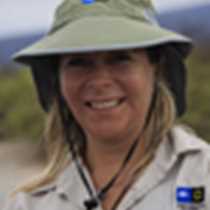Floreana Island
On this cool fresh morning, we started early to visit Post Office Bay on Floreana Island. Over two hundred years ago, pirates, buccaneers, whalers, sealers and the early colonizers landed at this very same spot. This is truly one of the most interesting historical sites in the Galápagos Archipelago. The National Geographic Islander anchored exactly where the ancient galleys once anchored and we went ashore in their footsteps.
Pirates carved caves in the highlands of Floreana; they came in search of land tortoises and they left goats behind, so they could hunt them when they returned to Galápagos. The caves were used through the centuries by early sailors and the pioneers who settled here. The first native boy born on Floreana Island was delivered in these caves! Presently there is a tiny community of about one hundred and twenty people living on Floreana. The small town of Puerto Velasco Ibarra, on the west coast of Floreana, is a model of the use of alternative energy; it is entirely powered by solar panels.
We visit this romantic island and hear some of the fantastic tales. We deliver our mail, and take post cards away with us, to hand deliver. The post office barrel was placed here by a whaling captain in the late seventeen hundreds. At this time, in 1793, Ecuador did not yet even exist as a Republic; it was still a colony of Spain. The Floreana post office was the first and most important mail system in the South Pacific. The wine barrel that still holds dozens of letters and cards is a tool for communication among the visitors to Galápagos who maintain this ancient marine tradition.
After breakfast we went by Zodiac to snorkel and then to search for land and sea birds around Champion Islet. Marvelously colorful king angelfish, playful sea lions and the unique and endangered Charles mockingbird where the highlights for this second morning outing. We were both amazed and thrilled with the morning’s experiences: striking human history and incomparable wild life!
Two rounds of kayakers had a blast in the afternoon kayaking in the company of sea lions and sea turtles along the coast at Punta Cormorant. Once the kayakers had returned to the ship, we all disembarked on the greenish olivine beach. We admired a fat sea slug and the tiny semi-precious crystals in the sand. The afternoon’s walk took us to the edge of a brackish lagoon where we had a close look at a group of flamingos. The adults were a gorgeous and brilliant pink; the juveniles still slightly gray but beginning to blush pink. We returned to the National Geographic Islander as the sun set behind a wall of gray and foreboding clouds: perhaps the rains will be coming soon. We hope so as we have had several years of dreadful drought.
On this cool fresh morning, we started early to visit Post Office Bay on Floreana Island. Over two hundred years ago, pirates, buccaneers, whalers, sealers and the early colonizers landed at this very same spot. This is truly one of the most interesting historical sites in the Galápagos Archipelago. The National Geographic Islander anchored exactly where the ancient galleys once anchored and we went ashore in their footsteps.
Pirates carved caves in the highlands of Floreana; they came in search of land tortoises and they left goats behind, so they could hunt them when they returned to Galápagos. The caves were used through the centuries by early sailors and the pioneers who settled here. The first native boy born on Floreana Island was delivered in these caves! Presently there is a tiny community of about one hundred and twenty people living on Floreana. The small town of Puerto Velasco Ibarra, on the west coast of Floreana, is a model of the use of alternative energy; it is entirely powered by solar panels.
We visit this romantic island and hear some of the fantastic tales. We deliver our mail, and take post cards away with us, to hand deliver. The post office barrel was placed here by a whaling captain in the late seventeen hundreds. At this time, in 1793, Ecuador did not yet even exist as a Republic; it was still a colony of Spain. The Floreana post office was the first and most important mail system in the South Pacific. The wine barrel that still holds dozens of letters and cards is a tool for communication among the visitors to Galápagos who maintain this ancient marine tradition.
After breakfast we went by Zodiac to snorkel and then to search for land and sea birds around Champion Islet. Marvelously colorful king angelfish, playful sea lions and the unique and endangered Charles mockingbird where the highlights for this second morning outing. We were both amazed and thrilled with the morning’s experiences: striking human history and incomparable wild life!
Two rounds of kayakers had a blast in the afternoon kayaking in the company of sea lions and sea turtles along the coast at Punta Cormorant. Once the kayakers had returned to the ship, we all disembarked on the greenish olivine beach. We admired a fat sea slug and the tiny semi-precious crystals in the sand. The afternoon’s walk took us to the edge of a brackish lagoon where we had a close look at a group of flamingos. The adults were a gorgeous and brilliant pink; the juveniles still slightly gray but beginning to blush pink. We returned to the National Geographic Islander as the sun set behind a wall of gray and foreboding clouds: perhaps the rains will be coming soon. We hope so as we have had several years of dreadful drought.




